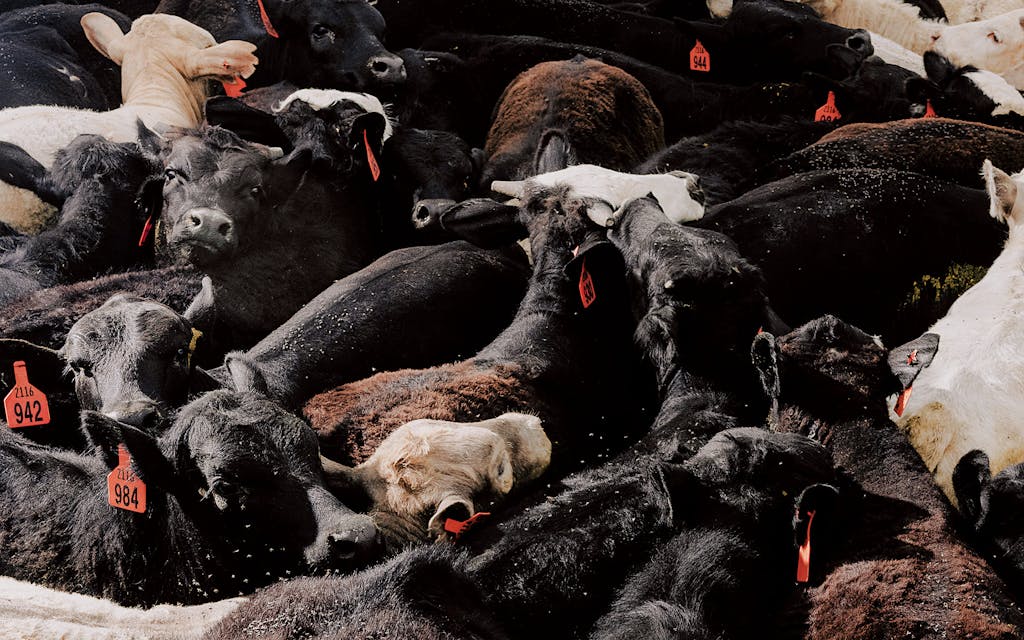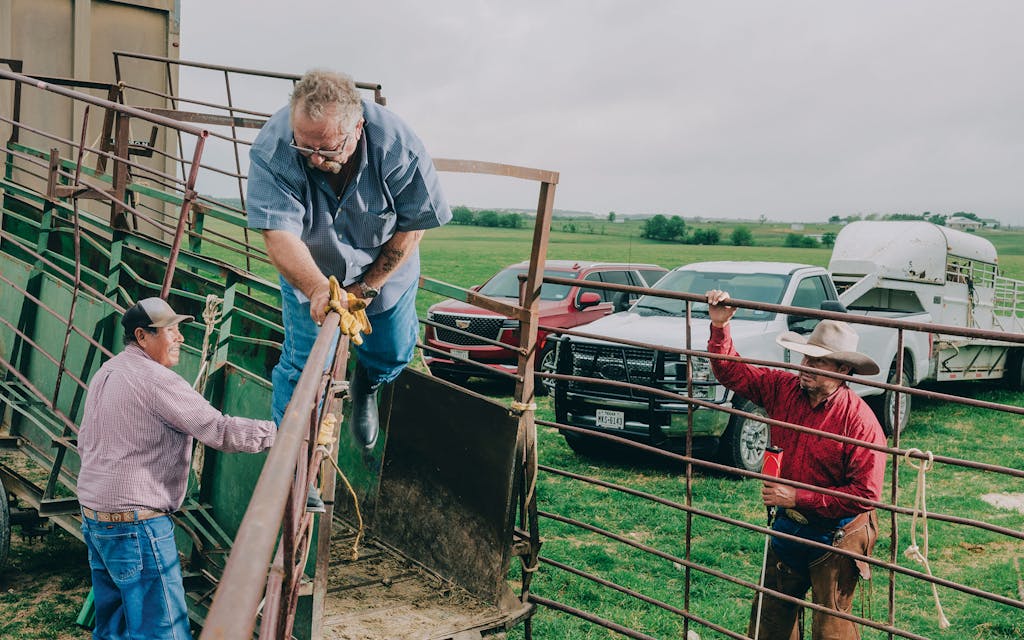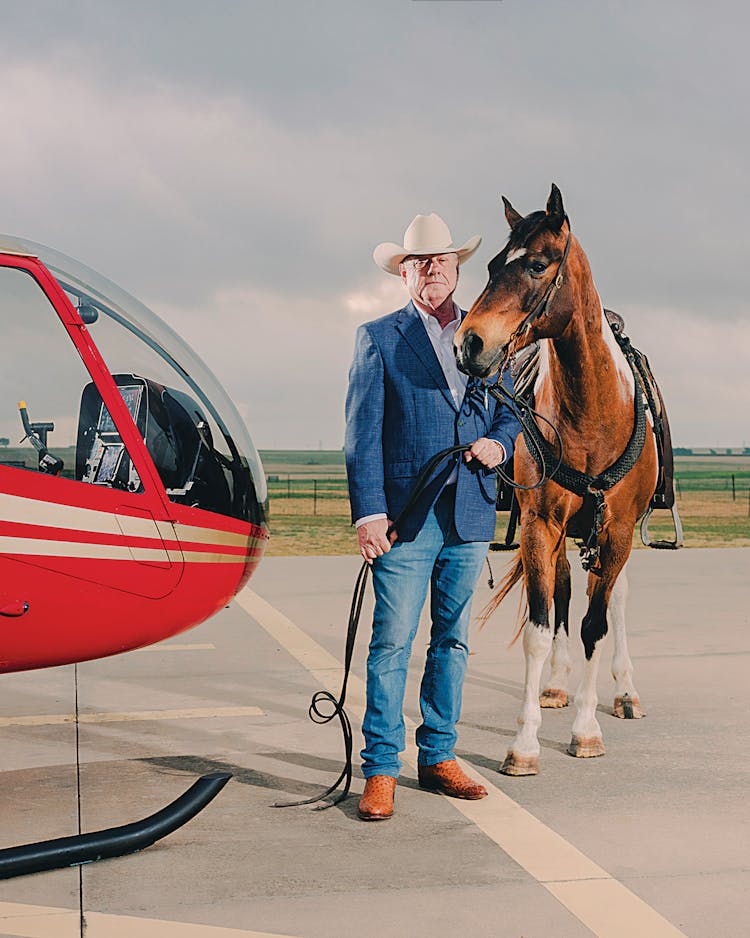Barreling forward at 125 miles an hour in his little red helicopter, Jim Schwertner gazes down upon a kaleidoscope of earth tones, patches in a 20,000-acre quilt. The dark khaki of the cornfields plays off the tawny grazing pastures. Both contrast starkly with the gray mazes of the surrounding subdivisions and the white limestone of empty lots nearby that will soon sprout McMansions and mixed-use developments.
Every couple of days, the 71-year-old president and CEO of Capitol Land & Livestock takes to the sky in his Robinson R66 chopper, which he refers to as his “horse.” He scans the Williamson County land, about an hour north of Austin, that’s home to his multimillion-dollar cattle-trading business. He likes to make sure the cattle are getting fed and moved to wherever they need to be, much as his father used to monitor the ranch’s operations from a beat-up old Chevy Suburban.
“Developers come to me almost every day to buy, but I won’t sell,” Jim told me over the helicopter’s intercom one morning in late February, as he circled back over a pasture for a better view of the herd below. Roughly a dozen cowboys were wrangling a hundred head into a double-decker tractor trailer that would deliver them to a feedlot in Amarillo. These cattle had been on Capitol’s land for 45 days, participating in a weaning process the company developed in the late eighties to ease calves along on their journey from mother’s teat to slaughterhouse. Jim says that Capitol weans more than 150,000 calves each year and that its clients pay $2 a head per day for the program, which reduces calf mortality rates from 5 percent down to 2 percent.
At any time, there may be 20,000 head of cattle munching Schwertner-made feed on Schwertner land, being rounded up by Schwertner cowboys, and loaded into Schwertner trucks, but to Jim, the beauty of his business is that the cattle are never really his company’s, at least not for much more than 24 hours. “We’re like day traders on the stock market, but with cattle,” he explains.
Capitol’s team of 25 buyers visits as many as 25 cattle auctions a day in Arkansas, Florida, Oklahoma, and Texas, buying hundreds of head on the strength of their word. (They don’t deal in written contracts.) All of those cattle are brought to the company’s ranch in the community of Schwertner, which Jim’s great-grandfather Adolf founded around the turn of the twentieth century, after emigrating from Austria.

At Schwertner, the cattle are sorted so that clients can place orders by weight, age, or sex. All are sold the day after Capitol buys them. Some of the six-month-old calves stay for the weaning, but the rest are packed into trailers, which can hold about one hundred each, and delivered to feedlots as far away as California and Washington State. Jim says that Capitol deals in 300,000 to 400,000 head a year, making it one of the largest cattle-trading companies in Texas and the nation.
The business has changed dramatically more than once since Jim’s father, Eugene, founded Capitol, in 1946. Back then, Texas was a predominantly rural state. Now the company’s ranch is surrounded by suburban development. That increasingly encroaching concrete serves as an apt visual metaphor for the threats facing the cattle industry as a whole, including rising land prices, a long-term decline in per capita beef consumption in the U.S. and worldwide, and calls to curb greenhouse gas emissions.
But the Schwertners have already survived market busts, droughts, digitization, and the passing of the company from one generation to the next. Capitol’s longevity can be credited to the sure-footed pivots it has made in the face of such changes. The beef industry’s future may be uncertain, but Jim is certain about his company’s ability to weather whatever lies ahead.

Bernard Schwertner and his sons—Frank, Edward, and Adolf—disembarked at Galveston Island in 1877. Upon learning that the family had been farmers back in Austria, immigration officials asked them what kind of soil they were used to. When the Schwertners described the dark, fertile earth of their native land, they were told to settle north of Austin, where the ground was similarly rich. And so they did, planting their flag on four hundred acres a couple of days’ ride from the state capital.
Adolf Schwertner proved the most adept at building a fortune in the New World. Just eighteen when he arrived in Texas, he farmed cotton, eventually acquiring a cotton gin in 1903. Six years later, when the Bartlett-Florence Railway Company was set to run a new rail line right through his property, Adolf sold and leased land and buildings alongside it, leading to the establishment of the unincorporated community that bears his family’s name. By 1915 the town boasted a market, a bank, a saloon, a boardinghouse, and a weekly newspaper. The community’s population peaked at about 500 in the late twenties before dropping significantly after 1935, when trains stopped running along the line. It’s been home to between 150 and 200 residents ever since.
Jim grew up hearing tales of his great-grandfather’s business acumen, and he told me some of them as we chatted at company headquarters, inside his office—a sprawling tiled room with cowhide chairs and a bookshelf full of family mementos, model airplanes, framed news clippings, and a photo of Jim with President Donald J. Trump. A picture of him with George W. Bush hangs on the wall. (His fourth cousin, Dr. Charles Schwertner, has been a Republican state senator since 2013, representing a district that includes all of Williamson County, as well as Bryan–College Station and Huntsville.) It was Adolf’s example that helped his grandson Eugene decide his next move after returning from four years of fighting in the Pacific during World War II. Among Adolf’s many other successful businesses was a mule auction, and Eugene figured he could replicate that achievement with cattle.
The beef industry was in the midst of a transformation. For decades, cattle had been sold through a system of what were called terminal auctions. Ranchers drove their herds to stockyards in cities with rail terminals, such as Denver, Fort Worth, and Kansas City, where they sold directly to meat markets. Because these were often long journeys, the ranchers couldn’t easily turn around and drive their herds back home if they weren’t satisfied with the going rates. This left them at the mercy of buyers who colluded with one another to keep prices low.
But the forties saw the advent of large-scale feedlots, a stop between the ranches and the meat markets where cattle could be fattened for slaughter. These operations started cropping up in the Midwest, and it wasn’t long before the trend made its way to Texas. Eugene saw a need for local auction houses, where ranchers could sell to feedlot operators and he could serve as the middleman. His timing was excellent; the large-scale feedlot industry ballooned in the fifties and sixties.
Capitol opened its first auction house in Austin in 1946, followed by others in Belton, Hondo, Karnes City, Lockhart, and Pleasanton over the course of the next fifteen years. Soon Eugene began acting as a broker, taking big orders from the feedlots and buying cattle on their behalf at his auctions. When the broker commissions became more lucrative than those Eugene was earning running the auctions, he sold all but his Lockhart location, to devote most of his time to brokering cattle. He turned the family land (which he’d bought from his father, Herman, who had inherited it from Adolf) into a distribution center where he could sort the cattle, realizing that feedlots had specific preferences according to size, age, breed, and sex.
Eugene continued looking for ways that his business could become more efficient and profitable, as when he started chartering planes so he could fly directly to ranchers. “My dad figured out early that if he could get to cattle first, the ones that weren’t at the auctions but from the big ranches, he could buy ’em there,” Jim recalls. “One of my father’s secret weapons was aviation.” Another secret weapon was Jim, who got his pilot’s license in 1968, when he was only seventeen, sparing his father the cost of paying others to fly him around.
Jim proved equally invaluable a decade later, after he graduated from Texas Tech University and went to work for Capitol full-time. Eugene was still a commission-based cattle broker when he tasked his son with buying the stock to fill orders he had sold. “I was young, just out of college, and I’d sometimes buy more cattle than he had sold,” Jim recalls. Eugene told his son, “Well, if you can’t pay more attention, then you need to sell ’em yourself.”
It was the mid-seventies, and the industry was going through another seismic shift, following a market crash caused by an overabundance of supply and the rising cost of feed corn. These conditions had wiped out a lot of ranchers, and a new breed of buyer arrived on the scene. These buyers weren’t cattlemen; they were commodity traders looking to take advantage of fluctuations in prices, aided by newly computerized access to the market. Jim realized that if he likewise followed the market closely, he could earn much more buying and reselling cattle than his father did in commissions. He had always been good at math, so he put together a formula—a proprietary algorithm that he loves talking about but declines to explain in detail, saying only that it “measures the supply of cattle every day and determines that if we buy a certain percentage of cattle, we have a seventy percent chance of winning.” When he showed his dad how they could grow the business by transforming it, Eugene was all in.


In 1975, the year after the Schwertners shifted into cattle trading, the average American was consuming 88 pounds of beef annually—roughly one Quarter Pounder a day. Annual per capita consumption is now about a third less, at 58 pounds. The U.S. beef industry produced more than 45 million head of cattle in 1975. That number has dropped by almost 15 million in the subsequent 46 years. Texas, which raises more beef cattle than any other state, saw its production drop by 33 percent during that same period, although modern breeding and feeding practices have yielded heavier animals, which each produce more beef.
The industry also faces public pressure to contend with its contributions to greenhouse gas emissions—thousands of cattle crowded into feedlots release huge amounts of methane into the atmosphere. Globalization has likewise complicated matters, with even an event as seemingly distant as Russia’s invasion of Ukraine, a major exporter of feed corn, adding to the costs of raising cattle.
“It might be difficult for us to continue to produce as much beef as we do,” says David Anderson, a professor of agricultural economics at Texas A&M University. One major obstacle to the market’s growth is urban sprawl, which gobbles up land historically used for ranching. With the state’s population growing by about six thousand a week, land prices are rising. In 2021 a pandemic-inspired rural land rush pushed the average price per acre to $3,251, up 9.5 percent compared with the previous year.
The costs of feed and fuel have also increased, and Texas ranchers have been culling their herds, the total size of which decreased by 3.5 percent in 2021—outpacing the national rate by more than a percentage point. “It is getting harder and harder to have enough cows to make a living as a rancher,” Anderson says. With the likelihood that the rest of 2022 will be marred by drought in Texas, it doesn’t appear as if that trend will soon reverse.
Capitol Land & Livestock built its business as the link between feedlots and small, independent ranches. When those ranchers struggle, there’s less for Capitol to buy from them. There were sixty or seventy other major cattle-trading companies in Texas in the mid-seventies, Jim says, but he guesses there are maybe twenty today. Capitol is a private company, and Jim won’t disclose how profitable it is. He says the company posts more than $300 million in annual sales, but he won’t discuss how that number compares with previous years.
Capitol employs about 125 accountants, buyers, cowboys, sellers, and truck drivers—up from roughly 75 in the late nineties. For the past two decades, Jim says, the company has moved about 400,000 head of cattle through its facility each year. Its landholdings have also grown considerably. When Eugene died, in 1998, Capitol owned about 8,000 acres, according to Jim. Today, the majority of its 20,000 acres are used as grazing land.
But that’s not the only use Capitol has found for all that land. Jim’s son Jimmy, a member of the third generation of Schwertners to work at Capitol (Jim’s nephew and brother-in-law also do), helped add another revenue stream to the family business. Jimmy studied acting at New York University and spent a decade as a Hollywood location scout. It was because of his connections that Wild Turkey was on the ranch the day I visited, filming a commercial for its bourbon with actor Matthew McConaughey. The Schwertners say they’ve hosted dozens of commercial, film, and television shoots during the past two decades, bringing in more than $200,000. “It’s funny ’cause they use the same locations all the time,” Jimmy tells me. “I’ve had four truck commercials shoot in the same riverbed.”
Neither Jim nor Jimmy admits to many worries about the future of the cattle business. The elder did acknowledge weather as a threat—he’s especially concerned about this year’s dry spell—but he won’t concede that global climate change is underway that could make such droughts more frequent and intense. He is wont to pontificate that “as long as Americans are going to McDonald’s, Ruth’s Chris Steak House, or anything in between, we’re in good shape.”
Indeed, despite the growing popularity of synthetic meats such as Beyond and Impossible Burgers, along with a 2020 poll indicating that one in four Americans says they’re cutting back on meat consumption, domestic demand has increased during the COVID-19 pandemic. (According to a report by agricultural research firm CattleFax, U.S. per capita beef consumption in 2021 was the highest it’s been in 33 years.) Even if that proves just a blip, Anderson believes the Schwertner family business will endure. “They have adapted and evolved to a changing industry,” he says of Capitol’s history as an auction business, then brokerage firm, then cattle-trading juggernaut. “There’s some real reason for optimism for them in the future.”
This article originally appeared in the June 2022 issue of Texas Monthly with the headline “The Cattle Trader’s Secret.” Subscribe today.

